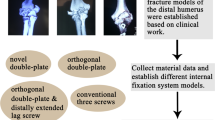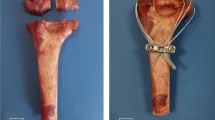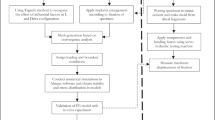Abstract
Treatment of a distal radius fracture should consider principles including stable fixation and early motion. The aim of this study was to investigate the biomechanical interactions of plate-fixation angles in the internal double-plating method coupled with various load conditions using non-linear finite element analysis (FEA). A 3D finite element distal radius fracture model with three separation angles (50, 70, and 90°) between the buttressed L- and straight plates was generated based on computed tomography data. After model verification and validation, frictional (contact) elements were used to simulate the interface condition between the fixation plates and the bony surface. The stress/strain distributions and displacements at the radius end were observed under axial, bending, and torsion load conditions. The simulated results indicated that the bending and torsion increased the stress values more than the axial load. The radius and straight plate stress values decreased significantly with increasing fixation angles for all load conditions. However, the L-plate stress values increased slightly under the bending buckling effect. The displacements at the radius end and strains at the fracture healing interface decreased with increasing fixation angles for axial and torsion conditions but displayed a slight difference for the bending condition. The findings using FEA provide quantitative evidence to identify that much larger plate fixation angles could provide better mechanical strength to establish favorable stress-transmission and prevent distal fragment dislocation.







Similar content being viewed by others
References
Adam C, Pearcy M, McCombe P (2003) Stress analysis of interbody fusion-finite element modelling of intervertebral implant and vertebral body. Clin Biomech 18:265–272
Alonso-Vázquez A, Lauge-Pedersen H, Lidgren L, Taylor M (2004) Initial stability of ankle arthrodesis with three-screw fixation. A finite element analysis. Clin Biomech 19:751–759
An KN, Chao EY, Cooney WP, Linscheid RL (1985) Forces in the normal and abnormal hand. J Orthop Res 3:202–211
Brown CJ, Wang CJ, Yettram AL, Procter P (2004) Intramedullary nails with two lag screw. Clin Biomech 19:519–525
Carrozzella J, Stern PJ (1988) Treatment of comminuted distal radius fractures with pins and plaster. Hand Clin 4:391–397
Chao EY, Opgrande JD, Axmear FE (1976) Three-dimensional force analysis of finger joints in selected isometric hand functions. J Biomech 9:387–396
Chen WP, Tai CL, Shih CH, Hsieh PH, Leou MC, Lee MS (2004) Selection of fixation devices in proximal femur rotational osteotomy: clinical complications and finite element analysis. Clin Biomech 19:255–262
Cooney WP, Chao EY (1977) Biomechanical analysis of static forces in the thumb during hand function. J Bone Joint Surg 59:27–36
Couteau B, Mansat P, Estivalèzes É, Darmana R, Mansat M, Egan J (2001) Finite element analysis of the mechanical behavior of a scapula implanted with a glenoid prosthesis. Clin Biomech 16:566–575
Dunning CE, Lindsay CS, Bicknell RT, Patterson SD, Johnson JA, King GJ (1999) Supplemental pinning improves the stability of external fixation in distal radius fractures during simulated finger and forearm motion. J Hand Surg 24:992–1000
Fang YC (1977) A first course in continuum mechanics, 2nd edn. Prentice-Hall Inc., NJ
Graff S, Jupiter J (1994) Fracture of the distal radius: classification of treatment and indications for external fixation. Injury 25(Suppl 4):14–25
Gesensway D, Putnam MD, Mente PL, Lewis JL (1995) Design and biomechanics of a plate for the distal radius. J Hand Surg 20:1021–1027
Greatting M, Bishop A (1993) Intrafocal (Kapandji) pinning of unstable fracture of the distal radius. Orthop Clin North Am 24:301–307
Horii E, Garcia-Elias M, Bishop AT, Cooney WP, Linscheid RL, Chao EY (1990) Effect on force transmission across the carpus in procedures used to treat Kienbock’s disease. J Hand Surg 15:393–400
Jakob M, Rikli DA, Regazzoni P (2000) Fracture of the distal radius treated by internal fixation and early function. J Bone Joint Surg 82:340–344
Lin CL, Wang JC, Kuo YC (2006) Numerical biomechanical Investigation of a tooth/implant-supported system with various connector designs and occlusal forces. J Biomech 39:453–463
Peine R, Rikli DA, Duda G, Regazzoni P (2000) Comparison of three different plating techniques for the dorsum of the distal radius: a biomechanical study. J Hand Surg 25:29–33
Périé D, Hobatho MC (1998) In vivo determination of contact areas and pressure of the femorotibial joint using non-linear finite element analysis. Clin Biomech 13:394–402
Pike LM, Wolfe SW (1997) Alternatives to bone graft in the treatment of distal radius fracture. Atlas Hand Clin 2:125–150
Putnam MD, Meyer NJ, Nelson EW, Gesensway D, Lewis JL (2000) Distal radial metaphyseal forces in an extrinsic grip model: implications for postfracture rehabilitation. J Hand Surg 25:469–475
Rashid H, Leung F, Lu W, Fung B, Chow SP (2003) Biomechanical evaluation of plate osteosynthesis for AO type C2 fracture of the distal radius-A cadaver study. Hand Surg 8:151–156
Renee DR, Brian DA, Goel VK (2002) An analysis of bone stresses and fixation stability using a finite element model of simulated distal radius fractures. J Hand Surg 27:86–92
Riis J, Fruensgaard S (1989) Treatment of unstable Colles’ fractures by external fixation. J Hand Surg 14:145–148
Rikli DA, Curtis R, Schilling C, Goldhahn J (2002) The potential of bioresorbable plates and screws in distal radius fracture fixation. Injury 33:77–83
Rogge RD, Adams BD, Goel VK (2002) An analysis of bone stress and fixation stability using a finite element method of simulated distal radius fractures. J Hand Surg 27A:86–92
Scifert CF, Thomas D, Brown TD, Lipman JD (1999) Finite element analysis of a novel design approach to resisting totalhip dislocation. Clin Biomech 14:697–703
Short WH, Palmer AK, Werner FW, Murphy DJ (1987) A biomechanical study of distal radial fracture. J Hand Surg 12A:529–534
Simon U, Augat P, Ignatius A, Claes L (2003) Influence of the stiffness of bone defect implants on the mechanical conditions at the interface—a finite element analysis with contact. J Biomech 36:1079–1086
Waters PM, Mintzer CM, Hipp JA, Snyder BD (1997) Noninvasive measurement of distal radius instability. J Hand Surg 22:572–579
Wolfe SW, Swigart CR, Grauer J, Slade JF, Panjabi MM (1998) Augmented external fixation of distal radius fractures: a biomechanical analysis. J Hand Surg 23:127–134
Author information
Authors and Affiliations
Corresponding author
Rights and permissions
About this article
Cite this article
Lin, CL., Lin, YH. & Chen, A.CY. Buttressing angle of the double-plating fixation of a distal radius fracture: a finite element study. Med Bio Eng Comput 44, 665–673 (2006). https://doi.org/10.1007/s11517-006-0082-9
Received:
Accepted:
Published:
Issue Date:
DOI: https://doi.org/10.1007/s11517-006-0082-9




